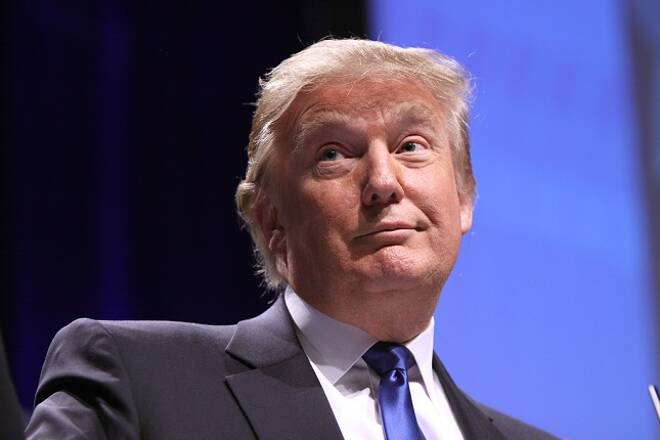Advertisement
Advertisement
Politics in Spotlight: Trump Discusses Firing Powell, Failed Spending Bill Shuts Down Government
By:
Congress specifically set up the Federal Reserve to “not become subject to political pressures that could lead to undesirable outcome.” Try to tell that to President Trump. The federal government partially shut down at midnight on Friday, hours after Congress failed to pass a spending bill that included $5 billion in funds for a wall on the U.S.-Mexican border.
The U.S. government was in the spotlight last with reports ranging from a one-sided spat between President Trump and U.S. Federal Reserve Chairman Jerome Powell to the shutting down of the U.S. government.
Questions were raised last week about the Federal Reserve’s role in the economy and government. Specifically, investors wanted to know why the Fed was working against President Trump’s plans to grow the economy.
According to the Federal Reserve’s website (www.federalreserve.gov), “the Federal Reserve is an independent agency but one that is ultimately accountable to the public and the Congress. The Congress established maximum employment and stable prices (inflation) as the key macroeconomic objectives of the Federal Reserve in its conduct of monetary policy. The Congress also structured the Federal Reserve to ensure that its monetary policy decisions focus on achieving these long-run goals and do not become subject to political pressures that could lead to undesirable outcomes.”
Essentially, the Fed is trying to maximize employment, which means maintaining a 5 percent or lower unemployment rate, while holding consumer inflation at about 2 percent. At this time, the Fed is close to achieving these goals with the unemployment rate at 3.7% and inflation hovering about 1.9%.
The Fed’s job is not to maximize values in the stock market or individuals’ retirement accounts although its decisions can influence both. However, in issuing its monetary policy statements, it often mentions its concerns about stock market volatility. During times of heightened volatility and economic uncertainty, the Fed tries to take action that does not sound too alarmist about the economy or too unconcerned about deteriorating financial conditions.
Trump Scolds Fed Chair Jerome Powell, Discusses Firing Him
Congress specifically set up the Federal Reserve to “not become subject to political pressures that could lead to undesirable outcome.” Try to tell that to President Trump.
Trump knows that the American people vote with their wallets and their retirement accounts. He based his entire campaign on the slogan “Make America Great Again”. Stock market investors have bought into his ideas since he was elected on November 9, 2016. Perhaps in reaction to his economic policies and tax cuts, he helped drive unemployment to near 50 year lows and the stock market to all-time highs. Since the all-time highs were reached in October, however, the stock market has taken back nearly 50% of the gains from election night.
Trump has been criticizing Fed Chair Powell since mid-July even telling the Washington Post on November 27 he’s “not even a little bit happy with my selection of Jay”. On what threatens the U.S. economy, Trump added, “I think the Fed is a much bigger problem than China.”
On December 11, Trump told Reuters “I think it would be foolish” for the Fed to raise interest rates. “But what can I say?” he said. “You have to understand, we’re fighting some trade battles and we’re winning. But I need accommodation too.”
He called Powell a “good man,” but added that “he’s trying to do what he thinks is best. I disagree with him I think he’s being too aggressive, far too aggressive, actually far too aggressive.”
On December 17, Trump tweeted: “It is incredible that with a very strong dollar and virtually no inflation, the outside world blowing up around us, Paris is burning and China way down, the Fed is even considering yet another interest rate hike. Take the Victory!”
Finally, on December 18, Trump tweeted again: “I hope the people over at the Fed will read today’s Wall Street Journal Editorial before they make yet another mistake. Also don’t let the market become any more illiquid that it already is. Stop with the 50 B’s. Feel the market, don’t just go by meaningless numbers. Good luck!”
Bloomberg reported on Saturday that U.S. President Donald Trump has discussed firing Powell. However, this isn’t going to happen because the firing of Powell would be seen as undermining the central bank’s independence from the administration.
U.S. Government Shutdown
The federal government partially shut down at midnight on Friday, hours after Congress failed to pass a spending bill that included $5 billion in funds for a wall on the U.S.-Mexican border.
This has happened before and it’s likely to happen again. Due do the heightened volatility and the thin-holiday trading conditions we could see some exaggerated moves in the markets but it’s not likely to become a major concern until the shutdown extends well past January 3, the day Congress is set to return from its Christmas break. Until then, there is likely to be a lot of blame being tossed around, but like Trump said two weeks ago, “I am proud to shut down the government for border security.” Furthermore, Trump also said “he’ll own it.”
About the Author
James Hyerczykauthor
James Hyerczyk is a U.S. based seasoned technical analyst and educator with over 40 years of experience in market analysis and trading, specializing in chart patterns and price movement. He is the author of two books on technical analysis and has a background in both futures and stock markets.
Advertisement
